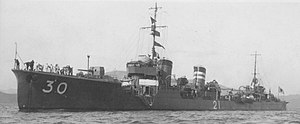Japanese destroyer Kisaragi (1925)

Kisaragi at anchor, February 1927
|
|
| History | |
|---|---|
|
|
|
| Name: | Kisaragi |
| Namesake: | February |
| Builder: | Maizuru Naval Arsenal |
| Laid down: | 3 June 1924 as Destroyer No. 21 |
| Launched: | 5 June 1925 |
| Completed: | 21 December 1925 |
| Renamed: | As Kisaragi, 1 August 1928 |
| Struck: | 15 January 1942 |
| Fate: | Sunk, 11 December 1941 |
| General characteristics | |
| Class and type: | Mutsuki-class destroyer |
| Displacement: |
|
| Length: | |
| Beam: | 9.16 m (30 ft 1 in) |
| Draft: | 2.96 m (9 ft 9 in) |
| Installed power: |
|
| Propulsion: | 2 shafts; 2 × Kampon geared steam turbines |
| Speed: | 37.25 knots (68.99 km/h; 42.87 mph) |
| Range: | 4,000 nmi (7,400 km; 4,600 mi) at 15 knots (28 km/h; 17 mph) |
| Complement: | 150 |
| Armament: |
|
| Service record | |
| Part of: | Destroyer Division 30 |
| Operations: | Battle of Wake Island |
Kisaragi (如月 ”February”?) was one of twelve Mutsuki-class destroyers, built for the Imperial Japanese Navy (IJN) during the 1920s. Retreating after the sinking of destroyer Hayate by American coast-defense guns during the Battle of Wake Island in December 1941, Kisaragi was sunk with all hands by American aircraft. She had the distinction of being the second major Japanese warship lost during the war (after Hayate earlier the same day). She should not be confused with an earlier World War I-period Kamikaze-class destroyer with the same name.
The Mutsuki class was an improved version of the Kamikaze-class destroyers and was the first with triple 61-centimeter (24 in) torpedo tubes. The ships had an overall length of 102.4 meters (335 ft 11 in) and were 94.54 meters (310 ft 2 in) between perpendiculars. They had a beam of 9.16 meters (30 ft 1 in), and a mean draft of 2.96 meters (9 ft 9 in). The Mutsuki-class ships displaced 1,336 metric tons (1,315 long tons) at standard load and 1,800 metric tons (1,772 long tons) at deep load. They were powered by two Parsons geared steam turbines, each driving one propeller shaft, using steam provided by four Kampon water-tube boilers. The turbines were designed to produce 38,500 shaft horsepower (28,700 kW), which would propel the ships at 37.25 knots (68.99 km/h; 42.87 mph). The ships carried 420 metric tons (413 long tons) of fuel oil which gave them a range of 4,000 nautical miles (7,400 km; 4,600 mi) at 15 knots (28 km/h; 17 mph). Their crew consisted of 150 officers and crewmen.
...
Wikipedia
